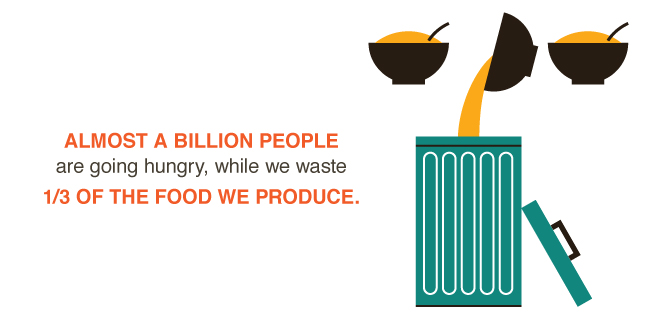Food Waste

Facts
- Globally, roughly one-third of the food produced for human consumption, about 1.3 billion tonnes per year, is lost or wasted (Gustavsson et al. 2011). Producing this much food accounts for 6–10% of human-generated greenhouse gas emissions (Vermeulen et al. 2012).
- People in Europe and North America waste 95–115 kg of food each year, compared with only 6–11 kg a year for people in Sub-Saharan Africa and South Asia (Gustavsson et al. 2011).
- The average carbon footprint of food wastage is about 500 kg of carbon dioxide (CO2) equivalents per person per year. Europe, North America, Oceania and industrial Asia have the highest per capita carbon footprint of food wastage (approximately 700–900 kg of CO2 equivalents per person per year), while sub-Saharan Africa has the smallest footprint per person (about 180 kg of CO2 equivalents) (FAO 2013a p. 22).
- Food waste is a huge problem globally, but the underlying reasons differ between regions.
- Food waste in high-income countries is dominated by consumer waste.
- Developing countries have high losses at the post-harvest and processing stages because of spoilage. Spoilage is high because of lack of modern transport and storage infrastructure, and financial, managerial and technical limitations in difficult climatic conditions (Venkat 2011; Gustavsson et al. 2011).
- The total amount of food wasted by consumers in industrialized countries is nearly as high as the total net food production in sub-Saharan Africa (FAO 2013b p. 295).
- Some 19.0% ± 5.8% of grain is lost in China along the whole supply chain, with the largest losses in the consumer segment (7.3% ± 4.8%). These food losses and waste in 2010 were estimated to waste the equivalent of 135 ± 60 billion m3 of water, equivalent to the total amount of water consumed in Canada. Such losses also imply that 26 ±11 million ha of land were used in vain, equivalent to the total arable land of Mexico (Junguo et al. 2013 p. 10137).
- The blue water footprint (i.e. the consumption of surface and groundwater resources) of food wastage is about 250 km3, which is equivalent to the annual water discharge of the Volga River or three times the volume of Lake Geneva (FAO 2013a p. 27).
- A total of 1.4 billion ha of land—28% of the world’s agricultural area—is used annually to produce food that is lost or wasted (FAO 2013a p. 37). This is equivalent to the areas of Canada and India put together, and dwarfed globally only by the size of Russia (1.7 billion ha).
- Food wastage costs food producers some USD 750 billion annually (FAO 2013a p. 55).
- High-income regions and Latin America are responsible for about 80% of all meat waste (FAO 2013a p. 58).
Sources and further reading
- [FAO] Food and Agriculture Organization of the United Nations. 2013a. Food wastage footprint. Impacts on natural resources. Summary report. Rome: FAO (Available from http://www.fao.org/docrep/018/i3347e/i3347e.pdf) (Accessed on 6 November 2013)
- [FAO] Food and Agriculture Organization of the United Nations. 2013b. Climate-smart agriculture sourcebook. Rome: FAO. (Available from http://www.fao.org/docrep/018/i3325e/i3325e.pdf) (Accessed on 6 November 2013)
- Gustavsson J, Cederberg C, Sonesson U, van Otterdijk R, Meybeck A. 2011. Global food losses and food waste. Rome: Food and Agriculture Organization of the United Nations. (Available from http://www.fao.org/fileadmin/user_upload/ags/publications/ GFL_web.pdf) (Accessed on 6 November 2013)
- Junguo L, Lundqvist J, Weinberg J, Gustafsson J. 2013. Food Losses and waste in China and their implication for water and land. Environmental Science & Technology 47: 10137−10144. (Available from http://dx.doi.org/10.1021/es401426b)
- Venkat K. 2011. The climate change and economic impacts of food waste in the United States. International Journal of Food System Dynamics 2(4):431–446. (Available from http://centmapress.ilb.uni-bonn.de/ojs/index.php/fsd/article/view/198/182)
- Vermeulen SJ, Campbell BM, Ingram J SI. 2012. Climate change and food systems. Annual Review of Environmental Resources 37:195–222. (Available from http://www.annualreviews.org/doi/abs/10.1146/ annurev-environ-020411-130608) (Accessed on 6 November 2013)